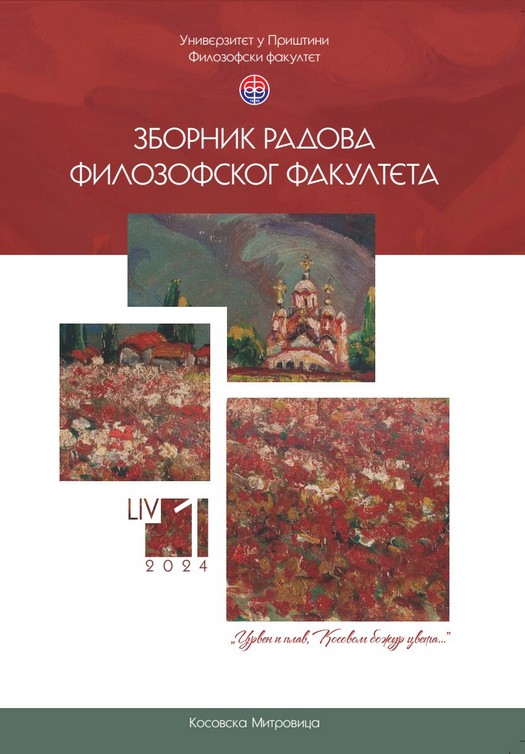A Comparative-Contrastive Analysis of Punctuation Use (and Spelling) in Serbian and English
Abstract
The paper investigates punctuation rules and their application in Serbian and English, focusing on the examples that comply with different normative solutions in the two languages. The main goal of the research is to compare and contrast the results obtained from a survey done by a group of seventh-grade primary school students. The paper aims to determine how well the respondents apply punctuation rules in Serbian and English, to examine whether there is interference in the application of rules, and to investigate to what extent the detected errors illustrate the tendency of spreading pseudo-norms that violate the orthography of both languages. The results show that the respondents use punctuation marks with more precision in Serbian than in English. The percentage of incorrect answers to each question and the types of errors indicate interference and the creation of hybrid forms that are incorrect in both languages, which represent the creation of pseudo-norms. Furthermore, the results show a greater influence of the application of the rules adopted in the Serbian language on the English language, which can be interpreted by the bigger number of Serbian classes and clearly stated topics within the syllabus of the Serbian language course.
References
Бабић, В. (2014). 365 језичких цртица. Београд: Креативни центар.
Блажић, М. (2015). Српски на српском. Београд: РТС.
Брборић, В. (2004). Правопис српског језика у наставној пракси. Београд: Чигоја штампа.
Брборић, В. (2018). Интерпункцијска терминологија код Срба од Вука до данас. У: Р. Драгићевић и В. Брборић (ур.), Српска славистика (стр. 61–73). Београд: Савез славистичких друштава Србије – Чигоја штампа. https://doi.org/10.18485/mks_srpska_slavistika.2018.1.ch4
Вуковић, М. (2022). Утицај англицизама са друштвених мрежа на српски језик и културу изражавања. Необјављена докторска дисертација. Универзитет у Приштини са привременим седиштем у Косовској Митровици, Филозофски факултет.
Гаврановић, В. и Чорболоковић, С. (2022). Компаративно-контрастивни приступ употреби великог слова у српском и енглеском језику. Књижевност и језик, LXIX (2), 415–427. https://doi.org/10.18485/kij.2022.69.2.11
Дилпарић, Б. и Савић, С. (2018). Интерпункција у преводу: немар или незнање. У: М. Лончар-Вујновић и др. (ур.), Наука без граница 1. Изван оквира (стр. 83–98). Косовска Митровица: Филозофски факултет Универзитета у Приштини.
Живић, Н. и Пивљаковић, И. (2019). Мали правописни водич. Београд: Службени гласник.
Кликовац, Д. (2011). О обради интерпункције у старом и новом издању Правописа српскога језика (Матица српска, 2010). Књижевност и језик, LVIII (3–4), 229–248.
Кликовац, Д. (2017). О знаковима у правопису (1): подела на реченичне и нереченичне и одговарајућа терминологија. Научни састанак слависта у Вукове дане, 46 (3), 95–111. https://doi.org/10.18485/msc.2017.46.3.ch7
Кликовац, Д. (2018). О знаковима у правопису (2): реченични знакови. Научни састанак слависта у Вукове дане, 47 (3), 69–85. https://doi.org/10.18485/msc.2018.47.3.ch5
Кликовац, Д. (2019). О знаковима у правопису (3): нереченични (помоћни) правописни знаци и неколико напомена о правописним знацима уопште. Научни састанак слависта у Вукове дане, 48 (3), 109–131. https://doi.org/10.18485/msc.2019.48.3.ch6
Ковачевић, М. (2022). Интерпункцијска правописна правила. У: В. Брборић и И. Бјелаковић (прир.), Нови прилози српском правопису (стр. 85–98). Нови Сад – Београд: Матица српска – Одбор за стандардизацију.
Милановић, А. (2019). Наводници: традиција и системност у српском правопису. У: М. Ковачевић (прир.), Нови прилози српском правопису (стр. 175–185). Нови Сад – Вишеград: Матица српска – Андрићев институт.
Пешикан, М., Јерковић, Ј. и Пижурица, М. (2019). Правопис српскога језика (измењено и допуњено издање). Нови Сад: Матица српска.
Прћић, Т. (2011). Енглески у српском (друго издање). Нови Сад: Филозофски факултет.
Шипка, М. (2007). Занимљива граматика (друго издање). Нови Сад: Прометеј.
American Psychological Association. (2020). Publication Manual of the American Psychological Association (6th ed.). Washington DC: American Psychological Association.
Chafe, W. (1988). Punctuation and the prosody of written language. Written Communication, 5(4), 395–426. https://doi.org/10.1177/0741088388005004001
Crystal, D. (2003). English as a Global Language (2nd ed.). Cambridge: Cambridge University Press.
Crystal, D. (2015). Making a Point: The Pernickety Story of English Punctuation. London: Profile Books.
Cushing, I. (2018). Cambridge Topics in English Language. Language Change. Cambridge: Cambridge University Press.
McMahon, A. M. S. (1994). Understanding Language Change. Cambridge: Cambridge University Press.
Мilinović, A. i Ninčević, S. (2012). Prinosi englesko-hrvatskom pravopisnom sup(r)о(t)stavljanju. Croatica et Slavica Iadertina, VIII/II (8), 369–393.
Sanchez-Stockhammer, C. (2018). English Compounds and Their Spelling. Cambridge: Cambridge University Press.
Schou, К. (2007). The syntactic status of English punctuation. English Studies, 88(2), 195–216. https://doi.org/10.1080/00138380601042790
University of Oxford Style Guide. (2014). Oxford: University of Oxford. https://www.ox.ac.uk/sites/files/oxford/media_wysiwyg/University%20of%20Oxford%20Style%20Guide.pdf
The details about the publication policy, including copyright and licensing, are available at:

